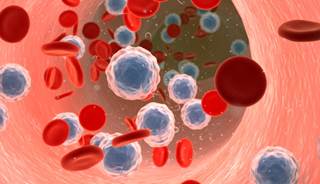
Diagnosed with SMM, SPB, or MGUS?
Learn how you can stall the development of full-blown Multiple Myeloma with evidence-based nutritional and supplementation therapies.
Click the orange button to the right to learn more.
- You are here:
- Home »
- Blog »
- Pre-Myeloma »
- Does Smoldering Multiple Myeloma Always Progress to full MM?
Does Smoldering Multiple Myeloma Always Progress to full MM?

“SMM is distinct from monoclonal gammopathy of undetermined significance (MGUS) due to a higher risk of progression to active MM disease. For patients at high-risk of progressing from SMM…”
No. Smoldering Multiple Myeloma (SMM) does not always progress to full MM.
SPB, MGUS and SMM are not cancer but they are a diagnosis of a blood disorder according to conventional oncology. The issue, if you are diagnosed with the blood disorders SPB, MGUS and SMM is your risk of progression to full-blown multiple myeloma (MM). It is MM that is an incurable blood cancer.
It is MM that causes damage to a person’s:
- bone,
- bone marrow,
- kidneys, etc.
According to research, SMM has a 10-15% chance of progression in years 1-3 with the risk declining to 3% during years 3-10 with this risk dropping further, to 1% thereafter.
- The first issue is to establish your level of risk based on your diagnostic info.
- The second issue is to undergo those evidence-based therapies shown to reduce the risk of a MM diagnosis.
The risk of developing full-blown MM is real. The question then is if anything can be done to prevent or slow a diagnosis of MM.
The third link below is an analysis of clinical trials testing various prevention strategies. The long and difficult to read study concludes that
“Evidence supporting early intervention is emerging, but without any demonstration of an improvement in the overall survival, patients with high-risk SMM are best managed in the clinical trials setting until we have more data.”
Anyone who has been diagnosed with SMM and who is considering a clinical trial testing prevention strategies, remember that the analysis of SMM clinical trials linked below is asking more questions than it answers.
Unanswered Questions Regarding Early Intervention for SMM
- Who Requires Early Intervention?
- What Is the Optimal Intensity of Early Intervention?
- What Is the Optimal Duration of Early Intervention?
Don’t misunderstand me. Chemotherapy for the SMM patient can increase the TTD (time to diagnosis). Unfortunately, chemotherapy does not increase the SMM patient’s length of life or quality of life. As always, chemo causes side effects.
Finally, the bottom article linked below highlights the only prevention strategy that I think is ready for SMM patients today. And that is evidence-based,
- non-toxic nutrition,
- supplementation and
- lifestyle therapies
shown to reduce the risk of MM and that can pre-habilitate the SMM patient if he/she ever does progress to full-blown MM.
Have you been diagnosed with smoldering multiple myeloma? Do you have any questions? Scroll down the page, post a question or a comment and I will reply to you ASAP.
To Learn More About Smoldering Multiple Myeloma- click now
In the meantime, hang in there,
David Emerson
- MM Survivor
- MM Cancer Coach
- Director PeopleBeatingCancer
Recommended Reading:
- Smoldering Multiple Myeloma Diagnosis 4,14 Translocation-
- Beating Myeloma: “If I Knew Then What I Know Now”
- MGUS Diagnosis- Reduce Risk of Multiple Myeloma
Risk stratification in smoldering multiple myeloma (SMM)
“SMM is distinct from monoclonal gammopathy of undetermined significance (MGUS) due to a higher risk of progression to active MM disease. For patients at high-risk of progressing from SMM, the main questions raised are; “should this subset of patients be treated as having MM?”.1…
Defining SMM
SMM is traditionally defined as an asymptomatic disease with an increased clonal burden, the presence of:
- Serum monoclonal protein IgG or IgA ≥3 g/dL or
- Urinary monoclonal (M) protein ≥500mg per 24 hours or
- Clonal BPMC of 10–60%
- No traditional CRAB features
Risk of progression from SMM to MM
Unlike MGUS which has a 1% risk of progression year on year, SMM carries a 15% risk within the first three years since diagnosis, which lowers to 3% between years three and 10, and drops to 1% at 10 years post-diagnosis.1 As SMM progresses into MM, there is an associated increase in M protein and BMPC percentage, as well as the development of end organ damage. Professor Kumar commented that this progression is a quantitative effect, over time. However, there are also qualitative genomic changes that occur over this time period within the plasma cells.
Table 1. Prognostic risk factors for 50% risk of progression in SMM1,2
| BMPC, bone marrow plasma cell ; FISH, fluorescence in situ hybridization; FLC, free light chain; GEP, genome expression profile | ||
| Quantitative | Qualitative | Both |
|---|---|---|
| Serum M protein ≥30g/L or progressive increase in M protein level | FISH abnormalities t(4;14), del(17p) or 1q gain | Serum involved/uninvolved FLC ratio abnormality ≥8 but <100 |
| Clonal BMPC 50–60% | Mutations | Immunoparesis with reduction of two uninvolved immunoglobulin isotypes |
| MRI with diffuse bone marrow abnormalities or one focal lesion | GEP | Circulating tumor cells |
| Increased circulating plasma cells | Proliferation rate | Evolving phenotypes |
| PET-CT with focal lesion and increased uptake without underlying osteolytic bone destruction | Abnormal plasma cell immunophenotype (≥95% of BMPCs are clonal) and reduction of ≥one uninvolved immunoglobulin isotype | |
Conclusion
Since SMM is a transitional state between MGUS and MM, it generally contains a mixture of patients with MGUS with polyclonal yet benign BMPCs and, patients with MM with malignant BMPCs. As such, no specific biomarker exists and it is not possible to morphologically identify SMM. The evolving definition of SMM will likely continue, based on latest data and advances in the field. This is necessary to ensure patients receive the best, and most appropriate care.”
Treatment of Smoldering Multiple Myeloma: Ready for Prime Time?
“We discuss evidence supporting early intervention for SMM—both as a preventative strategy to delay progression and as an intensive treatment strategy with a goal of potential cure. We highlight ongoing trials and focus on better defining who may require early intervention…”
4.1. Prevention
Recently, the Eastern Cooperative Oncology Group revisited lenalidomide in SMM in a larger randomized study, E3A06. This study evaluated 182 patients with SMM and randomized patients to lenalidomide, as a single agent without dexamethasone (n = 90) vs. observation (n = 92) [44]. Eligible patients had SMM with bone marrow plasma cells ≥10% and an abnormal sFLC ratio.
Cancer prehabilitation: One step toward improved outcomes
“Prehabilitation is not a new concept, nor is it specific to cancer. At its core, prehabilitation is designed to improve a person’s physical and psychological health in anticipation of an upcoming stressor. Furthermore, prehabilitation is part of the rehabilitation care continuum and is defined temporally as those assessments and interventions that occur after diagnosis but before acute treatment begins…
Many of the early studies on cancer prehabilitation typically focused exclusively on building strength and stamina through an appropriate exercise regimen; however, more recent research has supported a multimodal approach that encompasses more than one intervention (ie, a combination of exercise, nutrition, and psychological strategies) to better prepare patients for the challenges associated with upcoming cancer treatments.2…”


